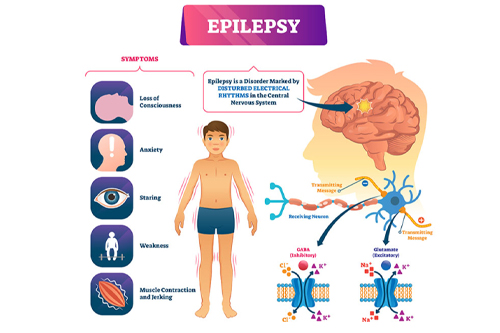
Epilepsy
Epilepsy is neurological condition that affects millions of people worldwide. It causes recurrent seizures, which result from sudden bursts of electrical activity in the brain. While some seizures are mild and barely noticeable, others can cause loss of consciousness and convulsions. Fortunately, advancements in medical research and technology have made epilepsy more manageable than ever bef
What Causes Epilepsy?
Several factors can lead epilepsy. In some cases, genetics play significant role, making individuals more prone to seizures. Brain injuries, strokes, infections, & developmental disorders can also contribute to condition. Furthermore, while doctors often identify specific cause, many cases remain unexplained. Understanding these triggers helps doctors develop effective treatment plans tailored to each patient’s needs.
Common Types of Seizures
- Focal Seizures (Partial Seizures): These start in one specific area of the brain and can be either:
- Focal Aware Seizures (Simple Partial): The person is conscious and aware of their surroundings, but they may experience unusual sensations or movements.
- Focal Impaired Awareness Seizures (Complex Partial): Consciousness is altered, and the person may seem confused or unaware of what is happening.
2.Generalized Seizures: These affect both sides of the brain from a beginning. Types include:
-
- Absence Seizures (Petit Mal): Brief lapses in awareness, often mistaken for daydreaming, lasting just a few seconds.
- Tonic-Clonic Seizures (Grand Mal): Characterized by muscle stiffening (tonic phase) followed by rhythmic jerking (clonic phase) and possible loss of consciousness.
- Myoclonic Seizures: Sudden, brief jerks and twitches of the muscles.
- Atonic Seizures: Sudden loss of muscle tone, which can lead to falls (also known as drop attacks).
- Tonic Seizures: Stiffening of muscles without rhythmic jerking.
- Clonic Seizures: Repeated jerking movements of muscles.
Diagnosing Epilepsy
To diagnose epilepsy, doctors rely on various tests that assess brain activity and identify possible triggers.
- Electroencephalogram (EEG): This test records electrical activity in the brain to detect abnormal patterns.
- MRI and CT Scans: These imaging techniques help identify structural issues, such as tumors or brain damage.
- Blood Tests: Blood work rules out infections or metabolic disorders that may cause seizures.
- Neurological Exams: A doctor assesses movement, reflexes, and cognitive function to gather more information
Effective Treatment Options for Epilepsy
Anti-seizure medications, also called anticonvulsants, are the most common treatment. They help stabilize brain activity, reducing the frequency and severity of seizures. Doctors prescribe medication based on the type of seizures, age, and overall health of the patient. While some people achieve complete seizure control, others may need to try multiple medications before finding the most effective one.
2. Dietary Therapy
Certain diets, such as the ketogenic diet, have shown positive effects in reducing seizures. The high-fat, low-carbohydrate nature of this diet changes brain metabolism, making seizures less likely to occur. Physicians often recommend this approach for children with drug-resistant epilepsy. 3. Vagus Nerve Stimulation (VNS)
VNS therapy involves implanting a device that sends electrical pulses to the vagus nerve, which helps regulate brain activity. This method works best for individuals who do not respond well to medication. 4. Epilepsy Surgery
For some individuals with severe epilepsy, surgery offers a chance to remove the brain region responsible for triggering seizures. If medications fail to provide relief, surgical interventions such as lobectomies or laser ablation may be viable options. Managing Epilepsy in Daily Life
Living with epilepsy presents challenges, but the right strategies can significantly improve quality of life. Here are some key tips for managing epilepsy effectively:
- Follow Medication Schedules: Taking prescribed medications consistently reduces seizure risks.
- Maintain a Healthy Lifestyle: Proper sleep, a balanced diet, and regular exercise contribute to better seizure control.
- Identify and Avoid Triggers: Common triggers include stress, flashing lights, and lack of sleep. Recognizing these factors helps minimize seizure occurrences.
- Use Medical Alert Devices: Wearing a medical bracelet ensures quick assistance during seizures.
- Build a Support Network: Connecting with family, friends, and epilepsy support groups provides emotional and practical support.
Prognosis and Living with Epilepsy:
- Many people with epilepsy live full, productive lives, and about 70% can achieve seizure control with proper treatment.
- Long-term management often involves a combination of medication, lifestyle adjustments, or regular monitoring.
- Individuals with epilepsy should be cautious with activities that could be dangerous during a seizure, such as swimming or driving, and should consult their doctor about safety precautions.
Future of Epilepsy Treatment
Ongoing research continues to bring hope to individuals living with epilepsy. Scientists are exploring gene therapy, personalized medicine, and brain stimulation techniques to develop more effective treatments. Additionally, artificial intelligence is playing a role in seizure prediction, allowing for better preventive measures. As research progresses, individuals with epilepsy can look forward to even more treatment options that enhance their quality of life.Contact Us
Conclusion
Epilepsy remains a complex neurological condition, but with the right treatments and lifestyle adjustments, many people live full and active lives. Understanding the causes, recognizing seizure types, and exploring advanced treatment options empower individuals to take control of their health. By staying informed and proactive, individuals with epilepsy can manage their condition effectively while looking forward to future medical advancements.Schedule your Consultation with Dr. Ritesh Nawkhare
